2.4 Functions
A function is a set of action or activity. For example, the function \(f(x)=2 x\) doubles the output value\(f(x)\) for every input \(x\) we provide.
Function in terms of relation
A relation \(f\) from a set \(\mathrm{A}\) to a set \(\mathrm{B}\) is said to be a function if every element of set \(\mathrm{A}\) has one and only one image in set \(\mathrm{B}\).
In other words, a function \(f\) is a relation from a non-empty set \(\mathrm{A}\) to a non-empty set \(\mathrm{B}\) such that the domain of \(f\) is \(\mathrm{A}\) and no two distinct ordered pairs in \(f\) have the same first element.
- If \(\mathrm{f}\) is a function from A to \(B\) and \((a, b) \in f\), then \(f(a)=b\), where \(b\) is called the image of \(a\) under \(f\) and \(a\) is called the preimage of \(b\) under \(f\)
- The function \(\mathrm{f}\) from \(\mathrm{A}\) to \(\mathrm{B}\) is denoted by \(\mathrm{f}: \mathrm{A} \rightarrow \mathrm{B}\)
Example 1: In the diagram below, we can say elements of B for example, 4 is an image of 2, and 16 is an image of 4. Similarly, we can say 5 is a preimage of 25. Therefore elements of set A are known as preimage with respect to set B, and element of set B is known as an image with respect to set A.
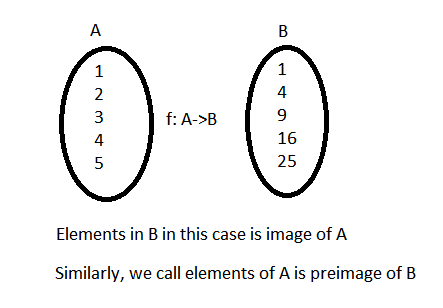
Function in terms of relation
\(\text { A relation is said to be a function if every element of set A has only } 1 \text { image/output in set } B \text {. }\) Let’s analyze the two cases in the figure below.
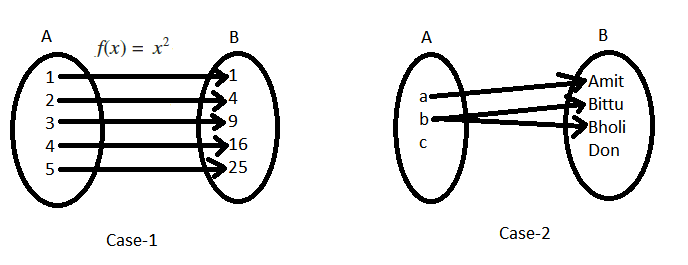
Case-1: In this case, every element of set A has only one image/output in set B. For example, for element 1 in the set, A output B has only one element which is 1. Therefore this relation between set A and set B is said to be a function (that is one input has only one output).
Case-2: In this example name starting with the letter a is only Amit, whereas for the letter b there are two names (two images) Bittu and Bholi. We can call this a relation but it can not be described as a function.
Note: In a function one input has only one output, one input can not have multiple outputs. But, multiple inputs can have one output.
Example 2: Whether relation below is a function or not?
\(P=\{(2,1),(3,1),(4,2)\}\)

Since two inputs point to one output, so this is not a function.
Example 3: Whether relation below is a function or not?
\(P=\{(2,2),(2,4),(3,3),(4,4)\}\)
Input element 2 is pointing to elements 2 and 4 in set B. This can not be a function.
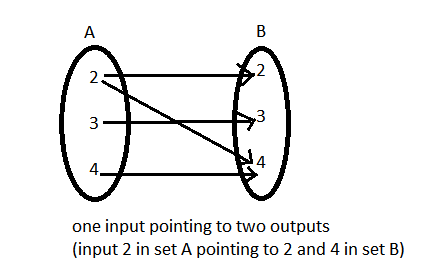
Example 4: Let \(\mathbf{N}\) be the set of natural numbers and the relation \(\mathrm{R}\) be defined on \(\mathrm{N}\) such that \(\mathrm{R}=\{(x, y): y=2 x, x, y \in \mathbf{N}\}\).
What is the domain, codomain and range of \(\mathrm{R}\) ? Is this relation a function?
Solution: The domain of \(\mathrm{R}\) is the set of natural numbers \(\mathbf{N}\). The codomain is also \(\mathbf{N}\). The range is the set of even natural numbers. Since every natural number \(n\) has one and only one image, this relation is a function.
Example 5: Examine each of the following relations given below and state in each case, giving reasons whether it is a function or not?
(i) \(\mathrm{R}=\{(2,1),(3,1),(4,2)\}\), (ii) \(\mathrm{R}=\{(2,2),(2,4),(3,3),(4,4)\}\)
(iii) \(\mathrm{R}=\{(1,2),(2,3),(3,4),(4,5),(5,6),(6,7)\}\)
Solution: (i) Since 2,3,4 are the elements of domain of \(\mathrm{R}\) having their unique images, this relation \(\mathrm{R}\) is a function.
(ii) Since the same first element 2 corresponds to two different images 2 and 4, this relation is not a function.
(iii) Since every element has one and only one image, this relation is a function.
Real Function: A function that has either \(\mathrm{R}\) or one of its subsets as its range is called a real-valued function. Further, if its domain is also either \(\mathrm{R}\) or a subset of \(\mathrm{R}\), it is called a real function.
Note1: In a Real function: Both range & domain \(\rightarrow \mathrm{R} \text { or subset of } \mathrm{R}\)
Note2: In a Real Valued function: Range \(\rightarrow \mathrm{R} \text { or subset of } \mathrm{R} \text { (that is output is } \mathrm{R} \text { but not input) }\)
Example of Real-Valued function:
Case-a:
A function, whose range is a set of Real Numbers, then that function is called a Real valued function. Let’s take this example shown in the Figure below. Is this a real-valued function?
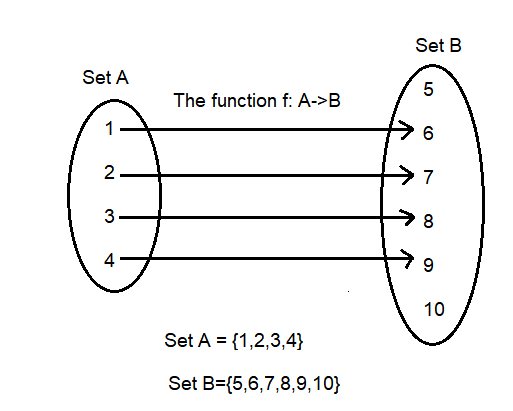
Explanation of the Solution:
The function f from A to B is denoted by \(f: A \longrightarrow B\). In this case, A is the domain of the function f and B is the codomain of the function f.
From the above diagram, we can easily say the Range of the function f. That is Range = {6,7,8,9} which consists of set of real numbers ( numbers 6, 7, 8, and 9 are all real numbers and constitute a set of real numbers).
Case-b: In the case shown in the figure below, is this a real-valued function?
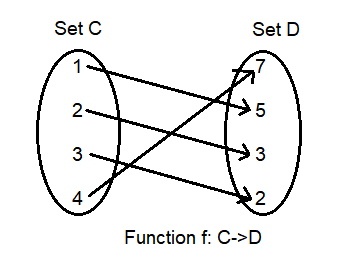
Explanation of the Solution: Every element in set C is related to exactly one element in set D, which makes it a function. Is it a real-valued function? Yes, it is a real-valued function because the Range: {2,3,5,7} consists of a set of real numbers.
Case-c: In the case shown in the figure below, is this a real-valued function?
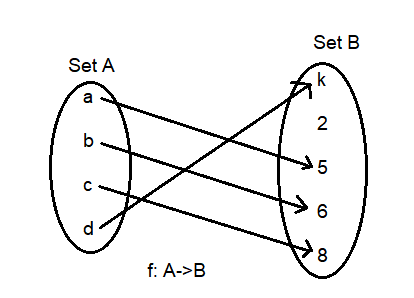
Explanation of the solution: Every element in set A is related to exactly one element in set B, hence it is a function. Is this a real-valued function? No, this is not a real-valued function as the Range ={k, 6,8,9} consists of element k which is not a real number.
Note: If the range consists of elements like 2i, 3i, or i which are imaginary numbers the function can not be a real-valued function.
Example of Real function:
A Real function is a function, whose domain and Range are the set of Real numbers. Let’s look at the examples below.
Case a:
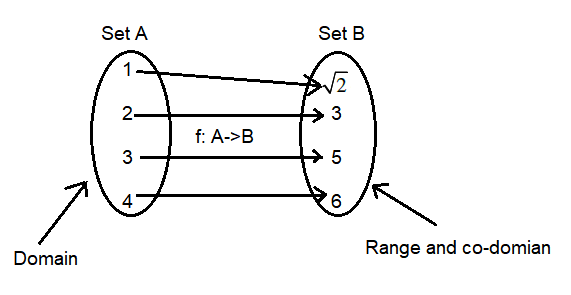
Explanation of the solution: We can see every element of set A is mapped to one element of set B which qualifies to be a function. Is this a real function? Yes, it is a real function because both Domain = {1,2,3,4} and Range = {\(\sqrt{2}\),3,5,6} are set of real numbers.
Case b: Consider the example shown in the figure below. Is this a real function?
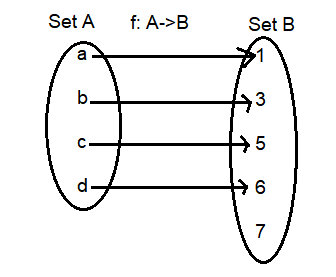
Explanation of the solution: In this example Domain = {a,b,c,d} is not a set of real numbers. Range = {1,3,5,6} is a set of real numbers. But for the real function both domain and range must be real. Since the domain is not real in this case, this function is not a real function.
Example 6: Let \(\mathbf{N}\) be the set of natural numbers. Define a real-valued function \(f: \mathbf{N} \rightarrow \mathbf{N}\) by \(f(x)=2 x+1\). Using this definition, complete the table given below.
\(
\begin{array}{|c|c|c|c|c|c|c|c|}
\hline x & 1 & 2 & 3 & 4 & 5 & 6 & 7 \\
\hline y & f(1)=\ldots & f(2)=\ldots & f(3)=\ldots & f(4)=\ldots & f(5)=\ldots & f(6)=\ldots & f(7)=\ldots \\
\hline
\end{array}
\)
Solution: The completed table is given by
\(\begin{array}{|c|c|c|c|c|c|c|c|}
\hline x & 1 & 2 & 3 & 4 & 5 & 6 & 7 \\
\hline y & f(1)=3 & f(2)=5 & f(3)=7 & f(4)=9 & f(5)=11 & f(6)=13 & f(7)=15 \\
\hline
\end{array}
\)
Some functions and their graphs
Identity function
A function is considered to be an identity function when it returns the same value as the output that was used as its input. Thus, an identity function maps each real number to itself. The output of an identity function is the same as its input.
Let \(\mathbf{R}\) be the set of real numbers. Define the real-valued function \(f: \mathbf{R} \rightarrow \mathbf{R}\) by \(y=f(x)=x\) for each \(x \in \mathbf{R}\). Such a function is called the identity function. Here the domain and range of \(f\) are \(\mathbf{R}\). The graph is a straight line as shown in Fig 2.4. It passes through the origin.
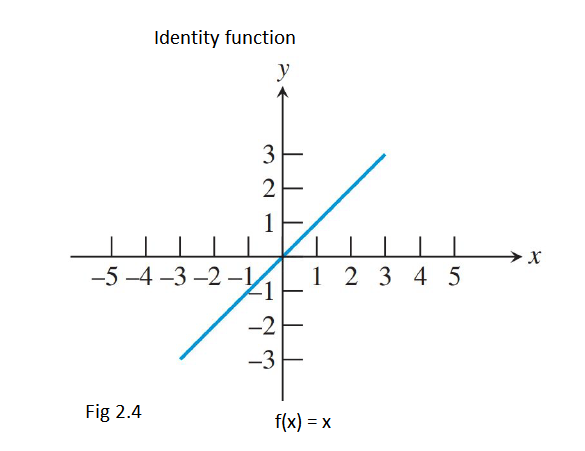
Example 7: A function that maps elements of set \(A=\{1,2\), \(3,4,5\}\) to itself. \(\mathrm{f}: \mathrm{A} \rightarrow \mathrm{A}\) such that, \(\mathrm{f}=\{(1,1),(2,2),(3,3),(4,4),(5,5)\}\). This is shown in Fig 2.5.

From the above-given image, we can see that the function f is an identity function as each element of A is mapped onto itself. The function f is one-one and onto.
Constant function
A constant function is a function having the same range for different values of the domain. Graphically a constant function is a straight line, which is parallel to the \(x\)-axis. The domain of the function is the \(x\)-value and is represented on the \(x\)-axis, and the range of the function is \(y\) or \(f(x)\) which is marked with reference to the \(y\)-axis. Any function can be considered as a constant function if it is of the form \(y=f(x)=c\).
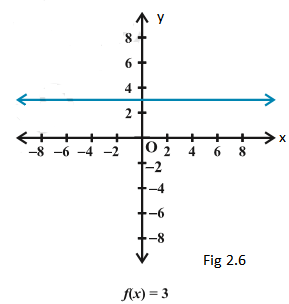
The graph is a line parallel to \(x\)-axis. For example, if \(f(x)=3\) for each \(x \in \mathbf{R}\), then its graph will be a straight line as shown in the Fig 2.6.
Example 8: Which of the following functions is/are constant functions?
a) \(f(x)=x^{2}+3\)
b) \(f(y)=y+(1 / y)\)
c) \(f(x)=3\)
d) \(f(x)=3+x\)
Solution:
The correct option is c) \(f(x)=3\) since its values do not depend on the variable \(x\). Its value remains 3 for any value of \(x\).
Polynomial function
A function \(f: \mathbf{R} \rightarrow \mathbf{R}\) is said to be polynomial function if for each \(x\) in \(\mathbf{R}, y=f(x)=a_{0}+a_{1} x+a_{2} x^{2}+\ldots+a_{n} x^{n}\), where \(n\) is a non-negative integer and \(a_{0}, a_{1}, a_{2}, \ldots, a_{n} \in \mathbf{R}\).
The functions defined by \(f(x)=x^{3}-x^{2}+2\), and \(g(x)=x^{4}+\sqrt{2} x\) are some examples of polynomial functions, whereas the function \(h\) defined by \(h(x)=x^{\frac{2}{3}}+2 x\) is not a polynomial function.(Why? – Since in the power (or exponent), only a whole number (or non-negative integer) is allowed, but \(2 / 3\) is not a whole number.). The graph of \(f\) is given in Fig 2.7.
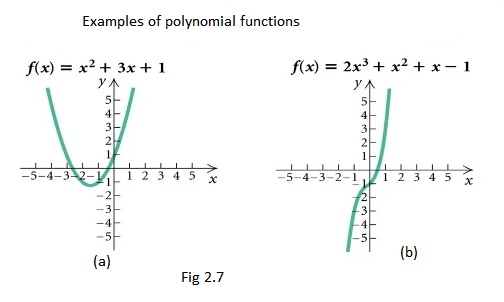
Example 9: Define the function \(f: \mathbf{R} \rightarrow \mathbf{R}\) by \(y=f(x)=x^{2}, x \in \mathbf{R}\). Complete the Table given below by using this definition. What is the domain and range of this function? Draw the graph of \(f\).
\(\begin{array}{|l|l|l|l|l|l|l|l|l|l|}
\hline x & -4 & -3 & -2 & -1 & 0 & 1 & 2 & 3 & 4 \\
\hline y=f(x)=x^{2} & & & & & & & & & \\
\hline
\end{array}
\)
Solution: The completed Table is given below (The resulting curved graph is called a parabola)
\(\begin{array}{|l|r|r|r|r|r|r|r|r|r|}
\hline x & -4 & -3 & -2 & -1 & 0 & 1 & 2 & 3 & 4 \\
\hline y=f(x)=x^{2} & 16 & 9 & 4 & 1 & 0 & 1 & 4 & 9 & 16 \\
\hline
\end{array}
\)
Here we are given \(x\) is real & we can put any value of \(x\)
Hence, Domain \(=\) All possible value of \(x= R\)
We note that \(f(x)\) has a minimum value of 0 and the value can increase up to infinity.
So, Range of \(f=\) All possible values of \(f(x)=[0, \infty)\)
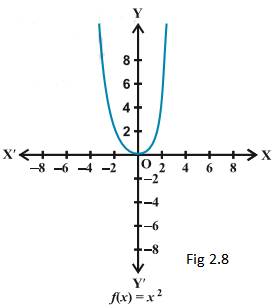
Example 10: Draw the graph of the function \(f: \mathbf{R} \rightarrow \mathbf{R}\) defined by \(f(x)=x^{3}, x \in \mathbf{R}\).
Solution: We have \(f(0)=0, f(1)=1, f(-1)=-1, f(2)=8, f(-2)=-8, f(3)=27 ; f(-3)=-27\), etc. Therefore, \(f=\left\{\left(x, x^{3}\right): x \in \mathbf{R}\right\}\). The graph of \(f\) is given in Fig 2.9 (also known as cubic function).
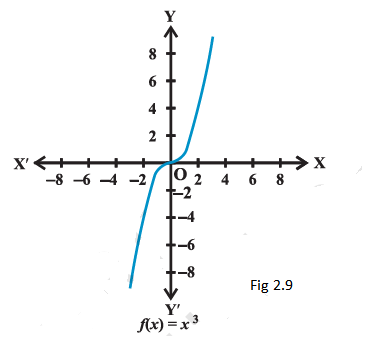
Rational functions
Rational functions are functions of the type \(\frac{f(x)}{g(x)}\), where \(f(x)\) and \(g(x)\) are polynomial functions of \(x\) defined in a domain, where \(g(x) \neq 0\). One example is \(f(x)=\frac{1}{x}\).
Example 11: Define the real-valued function \(f: \mathbf{R}-\{0\} \rightarrow \mathbf{R}\) defined by \(f(x)=\frac{1}{x}\), \(x \in \mathbf{R}-\{0\}\). Complete the Table given below using this definition. What is the domain and range of this function?
\(\begin{array}{|l|c|c|c|c|c|c|c|c|c|}
\hline x & -2 & -1.5 & -1 & -0.5 & 0.25 & 0.5 & 1 & 1.5 & 2 \\
\hline y=\frac{1}{x} & \ldots & \ldots & \ldots & \ldots & \ldots & \ldots & \ldots & \ldots & \ldots \\
\hline
\end{array}
\)
Solution: The completed Table is given by
\(\begin{array}{|l|l|l|l|l|l|l|l|l|l|}
\hline x & -2 & -1.5 & -1 & -0.5 & 0.25 & 0.5 & 1 & 1.5 & 2 \\
\hline y=\frac{1}{x} & -0.5 & -0.67 & -1 & -2 & 4 & 2 & 1 & 0.67 & 0.5 \\
\hline
\end{array}
\)
The domain is all real numbers except 0 and its range is also all real numbers except 0. The graph of \(f\) is given in Fig 2.10.
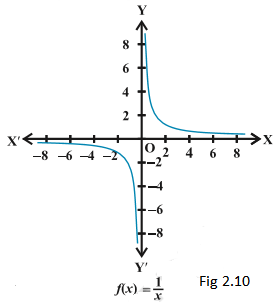
Modulus function
The function \(f: \mathbf{R} \rightarrow \mathbf{R}\) defined by \(f(x)=|x|\) for each \(x \in \mathbf{R}\) is called modulus function. For each non-negative value of \(x, f(x)\) is equal to \(x\). But for negative values of \(x\), the value of \(f(x)\) is the negative of the value of \(x\), i.e.,
\(
f(x)=\left\{\begin{array}{l}
x, x \geq 0 \\
-x, x<0
\end{array}\right.
\)
The graph of the modulus function is given in Fig 2.11.
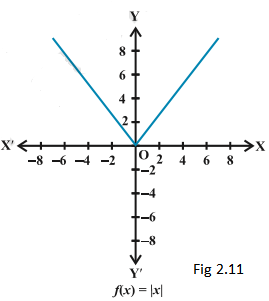
Signum function
The real function \(f: R \rightarrow R\) defined by
\(
f(x)=\left\{\begin{array}{c}
\frac{|x|}{x}, x \neq 0 \\
0, x=0
\end{array}=\left\{\begin{array}{clc}
1, & \text { if } & x>0 \\
0, & \text { if } & x=0 \\
-1, & \text { if } & x<0
\end{array}\right.\right.
\)
is called the signum function. Domain of \(f= R\), Range of \(f=\{1,0,-1\}\). The domain of the signum function is \(\mathbf{R}\) and the range is the set \(\{-1,0,1\}\). The graph of the signum function is given in the Fig 2.12.
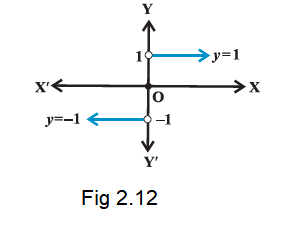
Greatest integer function
The function \(f: \mathbf{R} \rightarrow \mathbf{R}\) defined by \(f(x)=[x], x \in \mathbf{R}\) assumes the value of the greatest integer, less than or equal to \(x\). Such a function is called the greatest integer function.
From the definition of \([x]\), we can see that
\(
\begin{aligned}
&{[x]=-1 \text { for }-1 \leq x<0} \\
&{[x]=0 \text { for } 0 \leq x<1} \\
&{[x]=1 \text { for } 1 \leq x<2} \\
&{[x]=2 \text { for } 2 \leq x<3 \text { and }}
\end{aligned}
\)
so on. The graph of the function is shown in Fig 2.13.
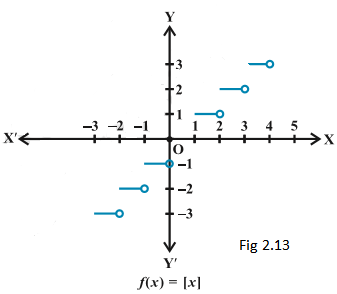
Algebra of real functions
In this Section, we shall learn how to add two real functions, subtract a real function from another, multiply a real function by a scalar (here by a scalar we mean a real number), multiply two real functions and divide one real function by another.
(i) Addition of two real functions: Let \(f: \mathbf{X} \rightarrow \mathbf{R}\) and \(g: \mathrm{X} \rightarrow \mathbf{R}\) be any two real functions, where \(\mathrm{X} \subset \mathbf{R}\). Then, we define \((f+g): \mathbf{X} \rightarrow \mathbf{R}\) by \((f+g)(x)=f(x)+g(x)\), for all \(x \in \mathrm{X} .\)
(ii) Subtraction of a real function from another: Let \(f: \mathrm{X} \rightarrow \mathbf{R}\) and \(g: \mathrm{X} \rightarrow \mathbf{R}\) be any two real functions, where \(\mathrm{X} \subset \mathbf{R}\). Then, we define \((f-g): \mathrm{X} \rightarrow \mathbf{R}\) by \((f-g)(x)=f(x)-g(x)\), for all \(x \in \mathrm{X}\).
(iii) Multiplication by a scalar: Let \(f: \mathrm{X} \rightarrow \mathbf{R}\) be a real valued function and \(\alpha\) be a scalar. Here by scalar, we mean a real number. Then the product \(\alpha f\) is a function from \(\mathrm{X}\) to \(\mathbf{R}\) defined by \((\alpha f)(x)=\alpha f(x), x \in \mathrm{X}\).
(iv) Multiplication of two real functions: The product (or multiplication) of two real functions \(f: \mathrm{X} \rightarrow \mathbf{R}\) and \(g: \mathrm{X} \rightarrow \mathbf{R}\) is a function \(f g: \mathrm{X} \rightarrow \mathbf{R}\) defined by \((f g)(x)=f(x) g(x)\), for all \(x \in \mathrm{X}\).
This is also called pointwise multiplication.
(v) Quotient of two real functions: Let \(f\) and \(g\) be two real functions defined from \(\mathrm{X} \rightarrow \mathbf{R}\), where \(\mathrm{X} \subset \mathbf{R}\). The quotient of \(f\) by \(g\) denoted by \(\frac{f}{g}\) is a function defined by ,
\(\left(\frac{f}{g}\right)(x)=\frac{f(x)}{g(x)}, \text { provided } g(x) \neq 0, x \in \mathrm{X}\)
Example 12: Let \(f(x)=x^{2}\) and \(g(x)=2 x+1\) be two real functions.Find
\(
(f+g)(x),(f-g)(x),(f g)(x),\left(\frac{f}{g}\right)(x)
\)
Solution: We have,
\(
\begin{aligned}
&(f+g)(x)=x^{2}+2 x+1,(f-g)(x)=x^{2}-2 x-1 \\
&(f g)(x)=x^{2}(2 x+1)=2 x^{3}+x^{2},\left(\frac{f}{g}\right)(x)=\frac{x^{2}}{2 x+1}, x \neq-\frac{1}{2}
\end{aligned}
\)
Example 13: Let \(f(x)=\sqrt{x}\) and \(g(x)=x\) be two functions defined over the set of nonnegative real numbers. Find \((f+g)(x),(f-g)(x),(f g)(x)\) and \(\left(\frac{f}{g}\right)(x)\).
Solution: We have
\(
\begin{aligned}
&(f+g)(x)=\sqrt{x}+x,(f-g)(x)=\sqrt{x}-x \\
&(f g) x=\sqrt{x}(x)=x^{\frac{3}{2}} \text { and }\left(\frac{f}{g}\right)(x)=\frac{\sqrt{x}}{x}=x^{-\frac{1}{2}}, x \neq 0
\end{aligned}
\)
Example 14: \(\text { Find the domain of the function, } f(x)=\left(x^2+3 x+5\right) /\left(x^2-5 x+4\right)\)
Solution:
\(\begin{aligned}
f(x) &=\frac{x^2+3 x+5}{x^2-4 x-x+4} \\
&=\frac{x^2+3 x+5}{x(x-4)-1(x-4)} \\
&=\frac{x^2+3 x+5}{(x-1)(x-4)} \\
(x-1)(x-4) \neq 0 \\
x-1 \neq 0 & \Rightarrow x \neq 1 \\
x-4 \neq 0 & \Rightarrow x \neq 4
\end{aligned}
\)
Therefore \(\text { Domain } \rightarrow R-\{1, 4\}\) (All real numbers except 1 and 4.)